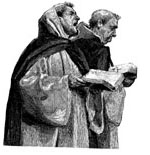
The Revivification of Sound Christian Philosophy
THE RISE & FALL OF THE THOMISTIC RENEWAL — PART I
In 1879, the second year of his pontificate, Pope Leo XIII issued Aeterni Patris, an encyclical that launched what was to become a singularly important event in the modern history of the Catholic Church: the Thomistic renewal, also known as the Neo-Scholastic revival. A renewal, or revival, was very much in order, because at the time Pope Leo wrote his encyclical Thomistic philosophy was, by and large, in a rather sickly condition, and had been for a good many years. Though there had been periods in the past when Thomism had the status of a philosophy whose influence was both potent and pervasive, this was not the case in the latter decades of the nineteenth century. But that state of affairs was to change dramatically with the publication of Aeterni Patris. The encyclical had the salutary effect of restoring some sorely needed vitality to Thomism, and within the span of two decades the philosophy became the animating core of a movement whose repercussions were felt throughout the Church. Few encyclicals have elicited the kind of immediate, positive response from the faithful that Aeterni Patris did.
The Thomistic renewal spread like a prairie fire, igniting new and enthusiastic interest in the thought of St. Thomas Aquinas among a wide range of Catholic philosophers and theologians, while at the same time giving encouraging support to a small but dedicated number of individuals who were already laboring to restore a vigorous Thomism to the Church. Beginning in the late nineteenth century, and continuing through the first half of the twentieth century, Thomistic philosophy once again became a prominent and authoritative presence within the Church. The rise and rapid growth of a revivified Thomism would easily have given a thoughtful observer at the time good reason to believe that the Thomistic renewal was in every respect a sterling success. It is amazing, as we look back at it now, to see how quickly and surely everything seemed to come together, but our amazement becomes perfect astonishment when we reflect on how quickly everything fell apart. The collapse of the Thomistic renewal took place with eye-blinking suddenness in the immediate aftermath of the Second Vatican Council. How is this singular happening to be explained? Before attempting to provide an answer to that question, it is well to look more closely at the Thomistic renewal itself.
Even otherwise well-informed Catholics can be excused for being surprised by the assertion that Thomism was, in the late nineteenth century, in a rather sorry state, and that there was thus a real need for a renewal. Has not Thomistic philosophy been, since the death of St. Thomas in 1274, more or less steadily in place as a large, universally accepted, and widely influential fact of Catholic thought and life? No. As a matter of fact, the history of Thomism — considered in terms of its influence within the Church over time — has been, since the fourteenth century, pretty much an up-and-down affair. By the eighteenth century, Thomism had arguably reached its nadir, having been adversely affected by the phenomenon called Decadent Scholasticism, the name given by historians to the culmination of the steady deterioration of Scholastic philosophy, a process whose origins can be traced back to the fourteenth century and the ascendency of nominalism. Thomism — one should really write “Thomism” — had reached an embarrassingly unbecoming condition; it had lost its focus and was no longer properly centered on the thought of St. Thomas himself.
In the nineteenth century, however, a genuine Thomism began to make a comeback, and though Aeterni Patris was the key factor, the renewal had its harbingers. Earlier in the century, before the publication of the encyclical, important work done by men such as Sanseverino, Signorelli, Cornoldi, and Zigliara in Italy, and by Kleutgen in Germany — all learned and dedicated scholars — prepared the way for the renewal.
You May Also Enjoy
The same God who instructs the heart also makes full use of intellectual concepts, syllogisms, and insights, including those found in philosophy and theology.
The scene: C.S. Lewis is sitting alone late at night at his big oak desk…
The effort of the Church to come to terms with the modern world too often assumes that contemporary culture is neutral when, in fact, it is closed to the transcendent.

